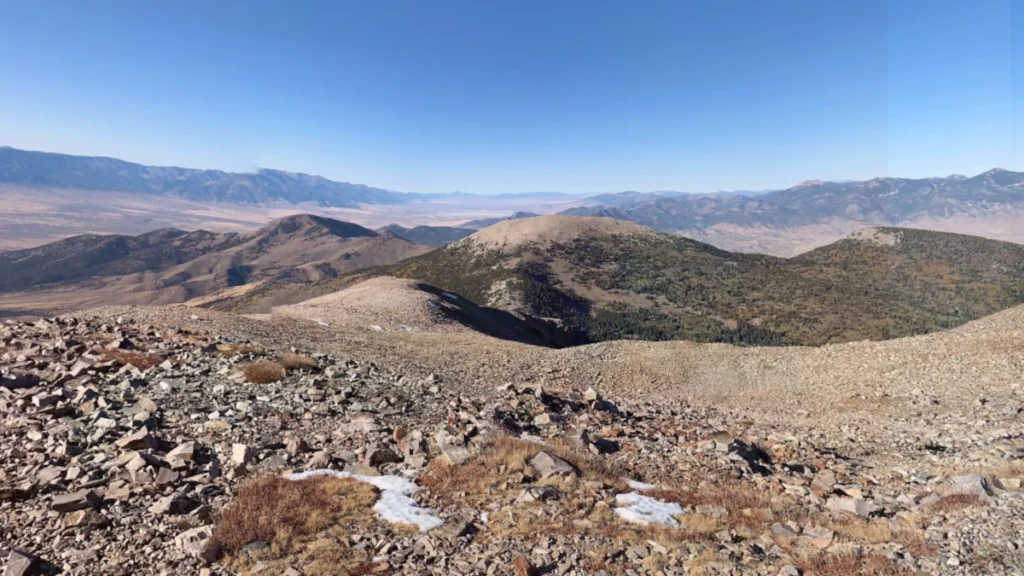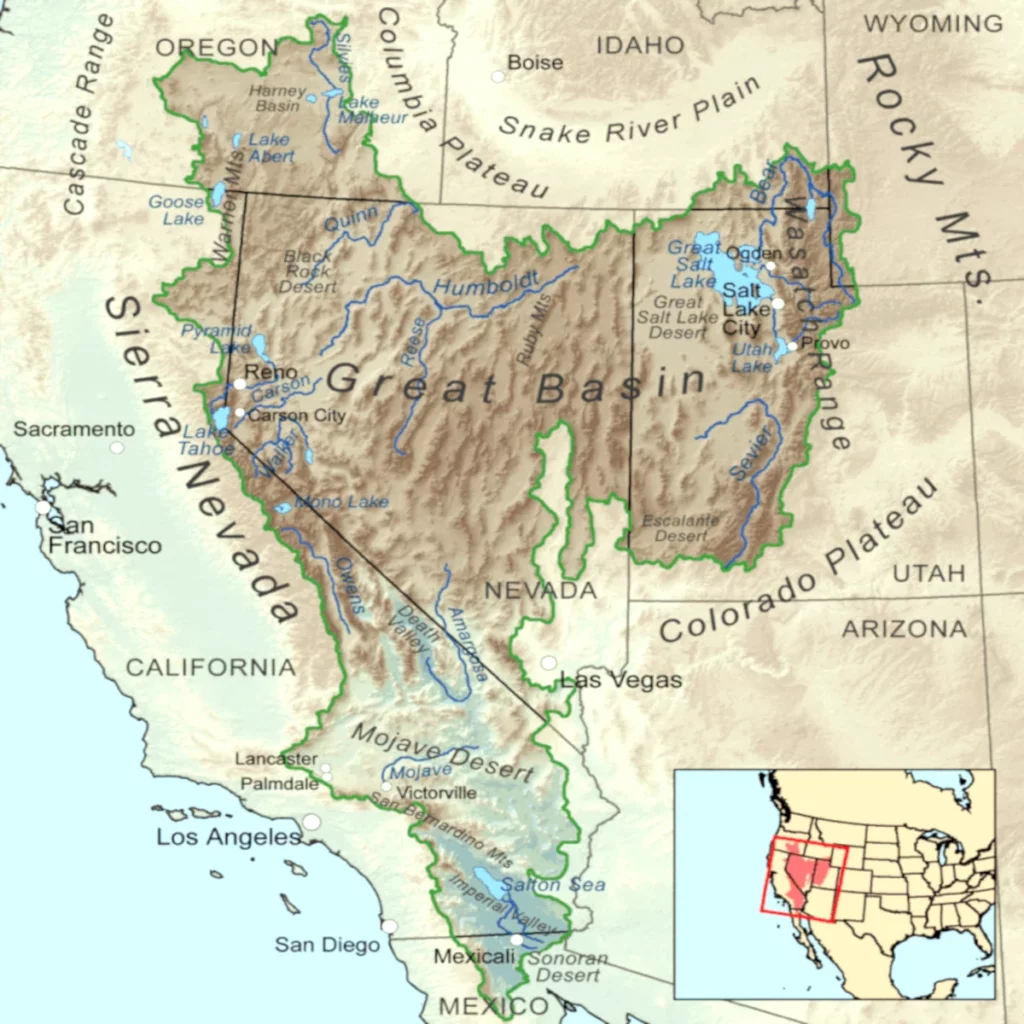The United States is home to a diverse array of landscapes, from the lush forests of the Pacific Northwest to the rugged mountains of the Rockies.
However, one of the most striking and unique regions in the country is the Great Basin Desert, the largest desert in the contiguous United States.
While the Chihuahuan Desert is the largest desert in North America, the Great Basin Desert takes the title for the largest desert entirely within the borders of the United States.

Geography and Climate
The Great Basin Desert covers an area of approximately 200,000 square miles, spanning parts of Nevada, Utah, Idaho, Oregon, and California.
This vast expanse is characterized by a unique geography, with a series of north-south trending mountain ranges separated by flat, dry valleys.
The climate of the Great Basin Desert is characterized by hot, dry summers and cold, snowy winters. Precipitation is sparse, with most areas receiving less than 12 inches of rain per year.
This arid environment is the result of the rain shadow effect, where the Sierra Nevada and Cascade mountain ranges block moisture-laden air from the Pacific Ocean, leaving the Great Basin in a rain shadow.
In addition to the Great Basin Desert, the United States is home to three other major deserts: the Mojave Desert, the Sonoran Desert, and the Chihuahuan Desert.
The Mojave Desert, located primarily in southeastern California and Southern Nevada, is the hottest desert in North America.
The Sonoran Desert, which spans parts of the Southwestern United States and northwestern Mexico, is the second-largest hot desert in North America.
The Chihuahuan Desert, which extends from the Southwestern United States into northern Mexico, is the largest hot desert in North America.

Ecology and Wildlife
Despite the harsh conditions, the Great Basin Desert is home to a diverse array of plant and animal life.
The region is dominated by sagebrush, which can thrive in the dry, alkaline soil. Other common plants include pinyon pine, juniper, and a variety of grasses and wildflowers.
The wildlife of the Great Basin Desert is equally adaptable, with species such as the pronghorn antelope, bighorn sheep, and the iconic black-tailed jackrabbit.
The region is also home to a variety of reptiles, including the Great Basin rattlesnake and the desert tortoise.
Human History and Settlements
The Great Basin Desert has a long history of human habitation, with evidence of Native American settlements dating back thousands of years.
The Paiute, Shoshone, and Ute tribes were among the first inhabitants of the region, relying on the area’s natural resources for sustenance and survival.
Today, the Great Basin Desert is home to a number of small towns and cities, including Reno, Nevada, and Salt Lake City, Utah. However, much of the region remains sparsely populated, with vast stretches of undeveloped land.
FAQs
What is the largest desert in the United States?
The largest desert in the United States is the Great Basin Desert, which covers an area of approximately 200,000 square miles. It spans parts of Nevada, Utah, Idaho, Oregon, and California, making it the largest desert entirely within the borders of the contiguous United States.
What are the other major deserts in the United States?
In addition to the Great Basin Desert, the United States is home to three other major deserts:
The Mojave Desert
The Mojave Desert is located primarily in southeastern California and Southern Nevada. It is the hottest desert in North America.
The Sonoran Desert
The Sonoran Desert spans parts of the Southwestern United States and northwestern Mexico. It is the second-largest hot desert in North America.
The Chihuahuan Desert
The Chihuahuan Desert extends from the Southwestern United States into northern Mexico. It is the largest hot desert in North America.
What is the climate of the Great Basin Desert?
The Great Basin Desert is considered a cold desert, meaning it experiences hot, dry summers and cold, snowy winters.
This is in contrast to the Mojave, Sonoran, and Chihuahuan deserts, which are classified as hot deserts.
The desert’s high elevation and location between mountain ranges, such as the Sierra Nevada and Rocky Mountains, create a rain shadow effect that limits the amount of precipitation the region receives.
Most areas in the Great Basin Desert receive less than 12 inches of rain per year.
What is the geography of the Great Basin Desert?
The Great Basin Desert is characterized by a unique basin-and-range topography, with wide valleys bordered by parallel mountain ranges.
This diverse landscape includes more than 33 peaks within the desert that reach heights of over 9,800 feet (3,000 m).
The significant variation in elevation has led to the development of a variety of habitat niches, which has in turn contributed to the region’s diverse array of plant and animal life.
What kind of plant and animal life can be found in the Great Basin Desert?
Despite the harsh conditions, the Great Basin Desert is home to a diverse array of plant and animal life.
The region is dominated by sagebrush, which can thrive in the dry, alkaline soil. Other common plants include pinyon pine, juniper, and a variety of grasses and wildflowers.
The wildlife of the Great Basin Desert is equally adaptable, with species such as the pronghorn antelope, bighorn sheep, and the iconic black-tailed jackrabbit.
The region is also home to a variety of reptiles, including the Great Basin rattlesnake and the desert tortoise.
How long has the Great Basin Desert been inhabited by humans?
The Great Basin Desert has a long history of human habitation, with evidence of Native American settlements dating back thousands of years.
The Paiute, Shoshone, and Ute tribes were among the first inhabitants of the region, relying on the area’s natural resources for sustenance and survival.
Today, the Great Basin Desert is home to a number of small towns and cities, including Reno, Nevada, and Salt Lake City, Utah.
However, much of the region remains sparsely populated, with vast stretches of undeveloped land.
Read also: These Are The Four Major Deserts of the USA

Your n°1 source of information on the world of sandsports and desert adventure travel. Our articles are the result of extensive research, personal experience, and knowledge-sharing within the global sandboarding community.